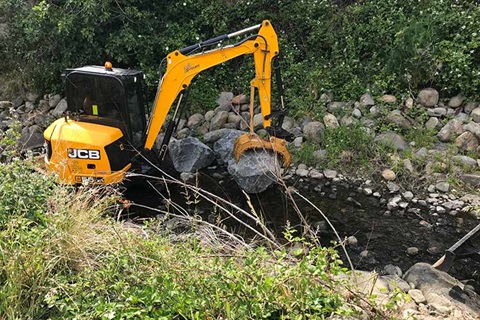Waterways on private property

Several waterways run through, or right next to private property in Hobart.
This can make it challenging for us to manage flow, as well as water quality and ecosystems, in a holistic manner across the entire catchment.
Notifying us
You may need to notify us if you undertake certain actions on or near waterways.
Please note: some of the codes in the planning scheme may also limit what you can do in or over waterways or along banks.
Building near waterways
You may wish to build structures in, along or over the waterway in your property such as retaining walls, fences and bridges.
Works will either need a riparian permit or planning permit depending on the nature of works. Before undertaking works, you should determine if a planning permit is required before submitting an application. This will help you avoid unnecessary costs. To do this, you can contact us to speak to the Planning team.
Otherwise, a work in a watercourse or riparian zone permit is required for ANY works which will impact a watercourse, on private or public land. This is to ensure impacts on the environment within and along the waterways caused by the works are minimized.
Weeding or planting on waterways
You may like to remove some weeds from the banks of the waterway, or undertake some planting.
There are many things you should consider before removing, or planting, any vegetation from the banks of a waterways. See our Revegetating Hobart's Waterways brochure(PDF, 131KB) for advice about riparian vegetation management. There is also information about what we are aiming to achieve across all of Hobart's rivulets.
How we can help
We can assist with managing waterways in certain circumstances.
Erosion
Waterways can erode the edge of your property.
Waterways on public and private land are all part of the stormwater system.
The meandering of waterways over time is a natural process and you should manage your property to accommodate this. For example, carefully consider the placement of sheds, fences and other buildings. Vegetation can assist in stabilising banks. Hardening of waterway embankments, such as retaining walls, is not permitted.
Blocked waterway
Waterways can become blocked.
Under the Urban Drainage Act 2013, the point of intervention is reached only when the flow of water is interrupted, and the risk to people and property is deemed to be significant. For example, if a large tree falls in the waterway and is blocking the flow, causing flooding and damage, the City will enter and remove it.
However, if the blockage is caused by private works, or trees fallen from private land, it is the landowners responsibility to remove the hazard. Otherwise it will be removed by the City at the landowners cost.